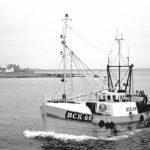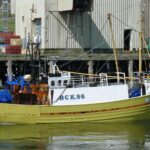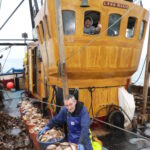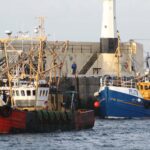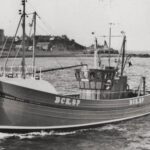Having clocked up almost half a century of service – under just three owners – this Isle of Man stalwart stands as a prime example of Herd & Mackenzie workmanship

Launch day for the Lynn Marie into Buckie harbour on 14 July, 1973.
When Thomas Mackenzie and James Herd started building fishing vessels at the inlet of Crooked Hythe at Findochty in 1905 – two years after they’d opened the yard (along with James’ cousin William Herd) – I guess those early pioneers of Scottish boatbuilding never envisaged that nearly 120 years later several of their wooden boats would still be working. But the Herd and Mackenzie yard was to become one of the most respected of Scottish fishing boatbuilders.
Today the inlet at Findochty lies silent, and you’d be forgiven for not realising that this spot is where it all started. Unless, of course, the ghosts of the sawpits and thumping hammers are heard on those very windy nights under a northeasterly gale…
By 1920 they had moved much of their operation to the eastern end of the new harbour at Buckie, where they had far more space. Throughout the next 50 years they built all manner of craft, including yachts and Admiralty vessels during the war, but fishing boats were always in the majority, and they really did build some crackers.

William Wilson’s wife about to christen the new vessel, with John Herd Mackenzie alongside her, adjusting his glasses. William Wilson is behind him, holding his son Iain.
One of those first appeared in 1973 when, with John Herd Mackenzie in charge (Thomas’ son, ‘The Boss’), they launched yard number 248, Lynn Marie BCK 86, for local Portessie man William Wilson. At just over 56ft, she was powered by a Volvo 270hp engine and was built as an open-decked trawler, though during her time in Buckie she had a shelterdeck added.
She was one of several builds, all under 25t and of a very similar shape and size, that included the Seagull BF 74 (1971), Silver Spray BCK 87 (1972) and Laurisa BA 145, built the same year as Lynn Marie. Seagull was slightly over 25t – and there were also, I was told, several steel versions, all helped by adjustments to the way boats were measured to allow the design to be stretched a little!
Willie Wilson was described to me as ‘a veteran of Lochinver’, having been there first when he was 15 on the Girl Elma BCK 106. Prior to ordering the new boat, in the early 1970s he was skippering the Eilean Shona BCK 228. He was a well-respected skipper, both for the way he fished and with regard to his vessels which were always in a tip-top condition – especially the Lynn Marie. When painted yellow, I’m told she was nicknamed ‘Lollipop’!
Lynn Marie fished the Moray Firth and North Sea grounds, mostly for whitefish and prawns, as well as targeting squid, especially in her later years in Buckie. She was a frequent visitor to both Kinlochbervie and Lochinver, and was one of some four dozen boats working out of Lochinver in 1985 that sponsored the Assynt Highland Games that year, along with other BCK vessels.

At sea off Buckie in the early days
When working from the northwest ports, she spent much time fishing the Clash Deeps for small whitefish, and then worked the winter prawns – she was, I was told, a ‘clean boat, not working rockhoppers’.
Willie fitted a twin net drum on the stern when twin-rigging started, which made the boat sit heavier in the water. The trawl winch was from Norlau of Norway, and one reel was hauled on the port side and the other to starboard, which was unusual then. The Silver Spray had the same arrangement.
The vessel also had a Decca Bridgemaster radar fitted. This turned out to be too big for the wheelhouse, which seems to have been small for this class of boat.
Lynn Marie stayed with the Wilson family for almost 40 years, with Willie’s son Iain taking over as skipper. In 2010 – by which time she was one of the last of the 1970s fleet working from Lochinver – they put her up for sale.

Coming in to Kinlochbervie. (Photo: Gary Sutherland)
She was sold to Geoffrey Chambers of Kilkeel and re-registered as N 264. Her shelterdeck was cut off, and the wheelhouse was ground smooth before being given the old-fashioned ‘scumble’ wood-grain-effect style. She was rigged for scallops with stainless steel sheeting, outriggers and goal posts. She fished mainly for scallops around the Isle of Man and north Irish coast during the winter months, and trawled for queenies off Rathlin Island during the summer.
On 9 April 2011, she was in collision with the Gibraltar-registered container feeder vessel Philipp six miles south of the Isle of Man, sustaining severe damage. The Philipp sailed on for another 20 miles before informing the Coastguard. Lynn Marie took on water, but the pumps were able to cope and she was towed back to Port St Mary by the scalloper Sarah Lena CT 18 and the lifeboat.
After temporary repairs in Port St Mary, she sailed to Macduff via the Caledonian Canal to be rebuilt. At the same time, a new whaleback, foremast and winch were installed. In July 2011, she sailed back to Kilkeel, where she continued to fish for scallops, queenies and prawns.

Repairs underway, with the starboard bow section replanked. (Photo: Darren Purves)
Geoffrey’s son Christopher, who worked aboard her from when his father bought her, told me that she was a great vessel to work on. “Lynn Marie was one of the best wooden boats of her time. Firstly, she was strongly built at Herd and Mckenzie, and then well looked after since she was built. She was a great sea boat – although, like all wooden boats, she liked to roll from time to time, I never felt unsafe on her.
“She had great deck space, and a large fishroom for the size of her. She really was a nice handy-sized boat for inshore scallop fishing, and travelling further afield when the weather suited. She was a well-proven boat whatever she went to, whether it was prawns, scallops or queenies. She also was a lovely shape of a boat.”

A good catch on the clams. (Photo: Darren Purves)
Largely due to the success of Lynn Marie, the Chambers family then took delivery of their new vessel Golden Shore N 153, built by Mooney Boats of Killybegs – a steel 49-footer designed to alternate between trawling for prawns, dredging for clams and queenie trawling. They therefore sold the Lynn Marie. She was bought by Billy Caley of Peel in the summer of 2016 and re-registered as PL 178.
The rake of her stem was altered so that some 12in was removed, decreasing her registered length to just under 50ft – thereby giving her access to the three-mile inshore waters of the Isle of Man.
She started fishing again in summer 2017, skippered by Wayne Caley, working the scallops around the Isle of Man and west coast of Scotland for most of the year. She is also rigged for queenies, but that gear hasn’t been used yet. This year the scallops have been good, and I’m told she’s one of the top boats. Not a bad for a 50-year-old vessel.
Silver Spray – also built in 1972, and some nine months older than Lynn Marie – is also still working. She has had several owners and name changes: Silver Star KY 154 (1983), Ajax AH 32 (1989), Ajax TO 32 (1990s) and now Good Fellowship BK 172. Both boats stand as testament to the exceptional skill, workmanship and first-class materials used under John Herd Mackenzie’s tenure at the yard from 1951 to 1979.
Thanks to John Macleod, Darren Purves and James Slater.
This story was taken from the archives of Fishing News. For more up-to-date and in-depth reports on the UK and Irish commercial fishing sector, subscribe to Fishing News here or buy the latest single issue for just £3.50 here.
Sign up to Fishing News’ FREE e-newsletter here.






